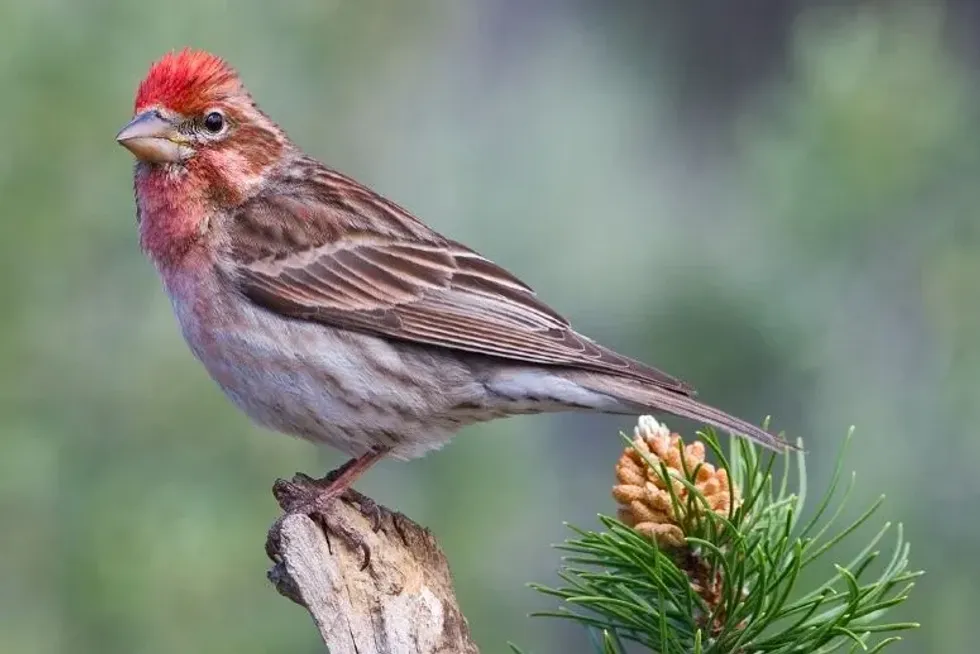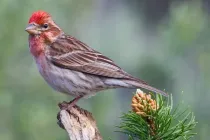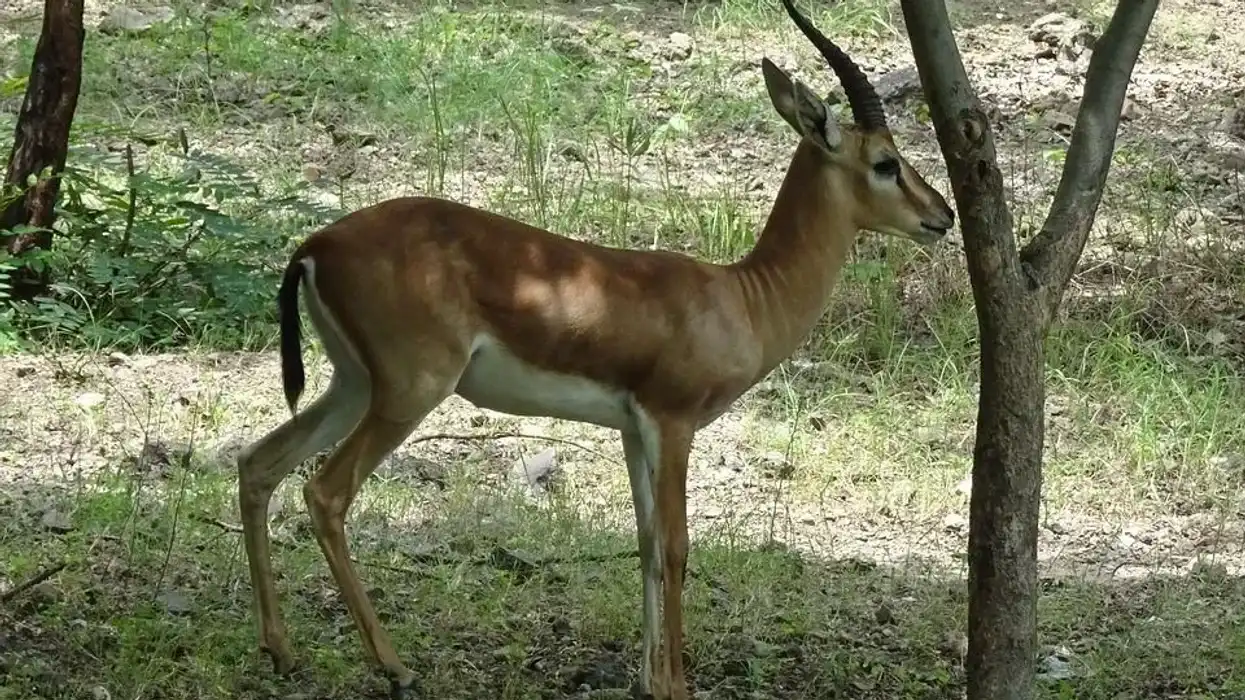The Cassin's finch is a very beautiful and colorful bird to learn about. Here are a few facts to give you a headstart on the bird.
The Cassin's finch belongs to the family Fringillidae. Belonging to the same family are the purple finch and the house finch. Although these birds are of the same family as the Cassin's finch, they can be distinguished on the basis of their appearance.
The red crown of the Cassin's finch is one of the most beautiful features of this bird. These beautiful, rosy pink-colored birds have an omnivorous diet.
It may seem that they are herbivores because of their dependence on seeds, fruits, and berries. However, during the winter season, they consume insects along with their natural diet of seeds and berries. However, the young ones have a different diet from adults.
The young birds rely mostly on a herbivorous diet till they are of age to consume and digest insects. Keep on reading to know more facts about the adult and young Cassin's finches.
For more relatable content, check out these willet facts and canyon wren facts for kids.
Cassin's Finch Interesting Facts
What type of animal is a Cassin's finch?
The Cassin's finch (Haemorhous cassinii) is a type of bird. Some other types of finches are red finch, house finch and purple finch.
What class of animal does a Cassin's finch belong to?
Cassin's finches belong to the class Aves.
How many Cassin's finches are there in the world?
As per the International Union for Conservation of Nature (IUCN) Red List, there are 3,000,000 adult individuals of this species residing in the world. The individuals are not too scattered, meaning that their population is not fragmented. However, their population is on a decline.
Where does a Cassin's finch live?
These birds are native to North America. The breeding range map of the Cassin's finches differs from their winter range map. During the breeding season, these birds are found in Arizona, Baja California, northern New Mexico, and Southern California. On the other hand, during winter, these birds reside in southern parts of the continent like central Mexico.
What is a Cassin's finch’s habitat?
The Cassin's finches prefer to reside in coniferous forests and evergreen forests during the breeding season. At this time, they can generally be seen at elevations as high as 10,000 ft (3048 m).
However, during the winter season, they fly down to lower elevations. They generally prefer a habitat filled with pines and aspens as they feed on these trees. Additionally, they can also be found in forests of fir, spruce, Douglas fir, and pinyon-juniper.
During the end of the summer season, they can be spotted in and around shrubs. The winter season, on the other hand, is mostly spent in open valleys and woods.
Who do Cassin's finches live with?
Cassin's finches are social birds who like to scavenge for food in groups or flocks. This happens towards the end of the summer season as well as at the onset of fall. They also migrate in flocks. Additionally, they pair up with an individual of the opposite sex during the breeding season.
How long does a Cassin's finch live?
Cassin's finches have an average lifespan of seven years.
How do they reproduce?
Male Cassin's finches form pairs with females during the end of winter or during early spring. This period marks the onset of the breeding season for these birds.
This is when they migrate to their breeding range from their winter range. There is not much detail about how pairs form and whether the birds have multiple partners or single ones.
After a pair forms between the male Cassin's finch and the female Cassin's finch, they move on to build the nest. The male and female of a pair build the nest during the months of May and June.
However, at times nests can be built by the male and female in July as well. On certain occasions, when a nest is built late it may be seen as a sign of rebuilding a second nest as an aftermath of the first one being destroyed by predators.
Nesting sites are chosen by females and males tag along. Sometimes, females opt for nests that are in the vicinity to the best of other females. However, the male will only let this happen if the adjacent pair have already laid their eggs.
Females go on to lay eggs after the completion of nesting. They can only give birth to one or at most a couple of clutches per nesting or breeding season.
3-6 eggs are laid per clutch. The eggs are a light blue or green in color.
They are dotted with brown, black, or purple spots. The eggs hatch pretty fast, the incubation period only lasts for about 12 days.
What is their conservation status?
These birds are marked as a species of Least Concern by the International Union for Conservation of Nature (IUCN) Red List. This means that there is no threat to their population as of now. However, the population of this species of finches is on the decline.
Cassin's Finch Fun facts
What do Cassin's finches look like?
The Cassin's finch has a forked tail. They have a red crown. This bright coloration of the crown is one of its most distinct features. The rest of their body downwards from their crown is rosy pink in color.
They also have white down feathers that are striped with brown color. Their underparts are dark-colored. They have a conical-shaped bill.
How cute are they?
These North American birds are extremely cute to look at. Their rosy pink color, especially on the crown of their head, makes them a sight for sore eyes. The round and fluffy appearance of this species of finches definitely adds to their looks. Not to forget, the tiny built of the bird adds to their cuteness factor as well.
How do they communicate?
Not much is known about the communication modes of this species of finches. This bird species are known to interact with their voice, touch, and sight, coupled with their hearing ability.
Like other animals, they can also perceive their surrounding environment with the help of chemical signals. The females are known to have a short and crisp call.
Males have a flight call which sounds like "tee-dee-yip" or "kee-up". In general, the songs of males and females are more cheerful, lengthier, and complicated than that of the house finch or the purple finch.
How big is a Cassin's finch?
The Cassin's finch birds measure about 6.3 in (16 cm) in length. These finch birds can be almost double the size of hummingbirds.
How fast can a Cassin's finch fly?
The speed at which this species of the finch bird flies remains unknown. This finch is a migratory bird. Hence, this North American finch bird has the ability to fly for days at a stretch.
How much does a Cassin's finch weigh?
This finch bird weighs approximately 0.8-1.2 oz (24-34 g).
What are their male and female names of the species?
The male of the species is known as a cock, while the female of the species `is known as a hen.
What would you call a baby Cassin's finch?
A young or baby Cassin's finch is called a chick.
What do they eat?
The Cassin's finch is an omnivorous bird. Their diet is mostly herbivorous during the summer.
On the other hand, they feed on insects during the winter. They feed on aspen buds, cottonwood buds, and green Manzanita buds during the spring and summer seasons. Other parts of the summer diet include seeds and fruits like berries, firethorn berries, apples, mulberries, and grapes.
The geographic range of the finch enables them to consume larvae of moths and butterflies that reside in the forests of Douglas fir. During the summer, they can also be spotted in a range filled with mineral deposits so that they can intake salt from these places.
Are they predators?
No, predatory nature is not possessed by the Cassin's finch. Cassin's finches are quite harmless.
Would they make a good pet?
Generally, finches make good pets, although not much is known about the pet Cassin's finch. Cassin's finches are generally harmless in nature. They have an omnivorous diet of insects, seeds, and berries. Hence, they are not a hassle.
Did you know...
Although Cassin's finch belongs from the same family as a house finch and a purple finch, the three have certain differences. While the entire head of a house finch is red, it is the crown of a Cassin's finch that's red. The house finch is also more striped.
Again, the plumage of the Cassin's finch rosy pink, while the color is a vibrant red or purple from the purple finch. The Cassin's finch has the longest beak of them all.
A house finch also differs from a purple finch. Most importantly, the difference lies in the color of their plumage. The house finch has an orangish-red plumage.
Meanwhile, the purple finch, as the name suggests, has a purplish hue to their feathers. The house finch is narrower in mass.
The tail of the house finch is longer than that of a purple finch. Additionally, the beak of a purple finch is longer and straighter. The purple finch also has a much softer call.
There are some telltale signs of identifying a finch. Their stout bodies and triangular-shaped beaks are their major giveaways. Additionally, they have a forked tail. Their brown and white striped plumage is also another identification sign. Also, since these birds generally live in small flocks, another similar bird can be spotted near them.
How smart are Cassin's finches?
Finches are generally considered to be smart birds. However, ample studies have not been conducted about Cassin's finch.
Why do finches sing?
The males of the species generally sing in order to attract the females. Males can also sing as a territorial warning to another male. The females can sing in order to give out signals of danger.
Here at Kidadl, we have carefully created lots of interesting family-friendly animal facts for everyone to discover! For more relatable content, check out these tricolored heron facts and night heron facts pages.
You can even occupy yourself at home by coloring in one of our free printable finch coloring pages.









